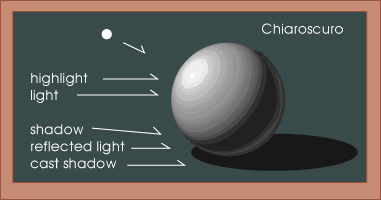
![]()

This is one means of strengthening an illusion
of depth on a two-dimensional
surface, and was an
important topic among artists of the Renaissance.
(pr. kee-ahr'oh-scyoo"roh)
Examples of the use of chiaroscuro:

Gerard David (Netherlandish, c. 1455 - 1523),
The Rest on the Flight into Egypt, c.
1512-15, oil on wood
panel, 20 x 17 inches (50.8 x 43.2
cm), Metropolitan Museum of Art, NY. See drapery,
Northern
Renaissance, and vignette.

Albrecht Altdorfer (German, c. 1480-1538),
Samson and Delilah (Judges 16:19), 1506,
pen and dark brown ink,
heightened with white,
on brown prepared paper,
6 11/16 x 4 3/4 inches (17.0 x 12.0 cm), Metropolitan Museum
of Art, NY.

Ugo da Carpi (Italian, active c. 1502-32),
designed by Baldassare Peruzzi (Italian, 1481-1536), Hercules Chasing Avarice from the Temple of the
Muses, c. 1518 (?), chiaroscuro woodcut from two blocks, Metropolitan
Museum of Art, NY.
Rembrandt Harmensz. van Rijn (Dutch, 1606-1669), Self-Portrait at Twenty-Two, 1628, oil on panel, 22.6 x 18.7 cm, Rijksmuseum, Amsterdam, Netherlands.
On May 28, 1998, Jody-Anne Maxwell (Jamaican, 1986-) won the Scripps Howard National Spelling Bee by correctly spelling the word "chiaroscurist" — an artist who uses chiaroscuro.
Also see grisaille, highlight,
and shadow.
https://inform.quest/_art
Copyright © 1996-![]()